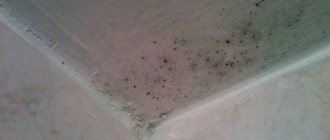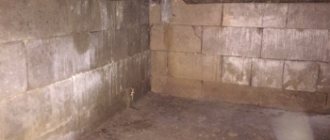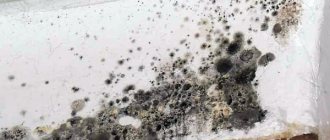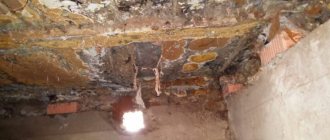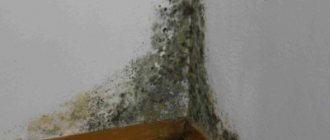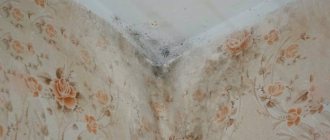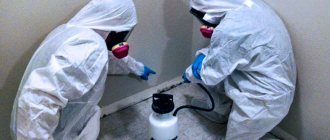Getting rid of progressive fungus
Regardless of how to remove fungus in the bathroom, it is important to determine the location of its formation.
Black dots are not the entire mycelium, so you need to get to the source of their formation. Usually, mold multiplies in voids, so you need to remove all the plaster; if the tile joints are affected, the grout is also scraped off. If some elements of the tile do not fit tightly to the wall, then most likely there is fungus underneath them too.
Further processing is reduced to the supply of dry heat. Use a hair dryer to dry the entire cleaned surface. Household heaters are suitable for this. Then the dry ceiling and walls on which there was fungus are treated with an antiseptic (dosage and other parameters of use are indicated in the instructions). Finally, the bathroom needs to be thoroughly warmed up again.
Causes of fungal infections
The best option is to initially prevent the appearance of harmful microorganisms. Fungal infections most often form in buildings where the humidity is 70% or higher and the temperature is around +150C. Basements, baths, toilets, rooms located in the corners of buildings, as well as rooms with a leaking roof are at risk. Fungus can appear due to improper ventilation. In this case, it is typical that condensation remains on surfaces, providing a favorable environment for the appearance of fungus. The occurrence of this type of infection may have a more serious cause and spread from a damp basement, which in turn gets there from the ground. In this case, the areas connecting the walls with the floor and ceiling will be infected. Another reason for the appearance of fungus can be problems with the sewerage system. Leaking pipes increase humidity and encourage the growth of dangerous bacteria.
How to paint the ceiling in the bathroom to prevent fungus
To prevent mold from appearing on the bathroom ceiling, you can paint it with silicate paint. Such paints are resistant to steam and moisture. In addition, they are famous for their antiseptic properties: they are not afraid of fungi.
Silicate paints are expensive, but their prices are completely justified. By treating the ceiling with this paint, you can forget that there was fungus on the ceiling in the bathroom.
Preventing the appearance of fungus is much easier than dealing with its consequences. To forget about mold in the bathroom forever, you need to get serious about prevention:
ventilate the room regularly, especially after a shower; promptly remove condensation from walls and other surfaces; use a heated towel rail to dry towels; take care to install a powerful fan in the hood; During repairs, pay special attention to joints into which water may enter. Treat them with sealant; do not lay tiles until the walls of the room are treated with an antiseptic; Check your plumbing regularly to prevent leaks; monitor the condition of the pipes; do not use the bathroom to dry clothes; do not allow water to stagnate in soap dishes and toothbrush glasses; regularly treat the walls of the room with special preventive compounds. Compliance with the above measures will protect the room from mold and keep the bathroom in perfect condition
Following these measures will protect the room from mold and keep the bathroom in perfect condition.
Watch the video and find out what product you can use to get rid of mold forever:
Why does mold and mildew appear on the ceiling in an apartment, how to deal with them?
A lot of methods for removing fungus are recommended on the pages of various sites, but the effectiveness of these tips needs to be better. The most effective way is to clean the affected area from the old plaster, dry it, treat it with an antifungal solution and re-plaster it. In this case, we will get rid of the fungus. This has been proven by many years of practice.
We also encountered this in our new apartment. Horror. In the bathtub, at the junction of the wall and the bathtub itself, I had to treat the area where it appeared with vinegar and copper sulfate (it is sold in a hardware store), and now there is nothing.
In our rented apartment there was black mold on the bathroom ceiling painted with water-based paint. I washed it with a solution of boric acid and soda, then my husband repainted the ceiling with silicate paint. It seems that mold has not been visible for six months now. I regularly check the ceiling and tile joints; I am afraid that mold spores remain and it may germinate again.
To be honest, I never thought about the consequences of mold in the shower. No, of course, I knew it was bad, but I still couldn’t get around to getting rid of it. After reading the article, my husband and I found the causes of some of our ailments. Still, they decided to remove it. For now, let’s try to wash it using traditional methods, because we don’t have much of it. And in the future we will make repairs so that it does not appear again.
I previously tried covering black fungus in the bathroom with white. This method helped when the fungus was just beginning to spread. But I ran it a little and tried, as you wrote here, soda and vinegar, I’ll see how it helps, thanks for the advice.
I think that when the fungus in the bathroom has already started, nothing will save you other than cleaning everything up and doing repairs from scratch. The fungus can still be removed at an early stage using special means, but this will also not last long. Because in any case, you can miss a section of the fungus and it will continue to grow. It’s better to uproot everything, so to speak, and do it all over again.
I am familiar with the problem of mold in the bathroom. The seams in the entrance are leaking. Because of this, the entire wall in the bathroom is damp. They called specialists, they told us that until we insulate the apartment and seal the seams, there would be no point. I'll try the tips from the article, maybe it will help.
New publications:
Reproduction of site materials is possible only if a full active link to the source is indicated.
How to prevent the occurrence
Preventing mold from occurring is much easier than getting rid of it. To avoid encountering the problem again in the future, you should:
- Check the heating system periodically.
- repair pipes as soon as even slight leaks are noticed.
- monitor the proper functioning of the ventilation system in rooms with high humidity (bathroom and kitchen).
- To decorate the ceiling in the bathroom, you should not waste time purchasing waterproof coatings.
Even if you have dealt with mold on a suspended ceiling, it is important not to forget to treat the surface to prevent further occurrence and spread of new mycelium.
Did you like the article? Like ♥, subscribe to our channel and you will be one of the first to know about new publications!
And if you have something to share, leave your comments! Your feedback is very important to us!
Causes
Neighbors upstairs. Living next to neighbors is not always good, since flooding situations are not uncommon in our country. Moreover, water from your neighbors does not necessarily drip from your ceiling. Small crevices and cracks allow minor seepage. As a result, your ceiling becomes covered with fungus. Problems with the heating and water supply system
Pay special attention to ceilings and pipe seams, which can gradually become damp. Don’t rush to blame your neighbors for all their sins and don’t blame everything on condensation
Better check the riser. Sewer joints. Once the sewerage system breaks its tightness, excess moisture will become a common occurrence in your bathroom. Poor ventilation. Even if everything works fine, the pipes are sealed, moisture may simply not be removed from the room well. The reason for this is ventilation. It either works poorly or does not perform its functions at all. Condensate. Also a common cause of fungus. Cold water passes through the pipes, condensation appears, flows down the floor, and seeps into the ceiling. Excessive freezing of walls. With poor thermal insulation or poor heating in winter, you may encounter moisture condensing directly through the walls and capturing the ceiling. A little time passes, and the fungus already feels like home.
Danger
You should not think that the problem of fungus appearing on the ceiling lies solely in the aesthetics of the room. In other words, the room looks unsightly.
There are much more serious consequences that these microorganisms can lead to:
- Mold releases dangerous, toxic substances that are harmful to humans. This is especially dangerous for children who may have problems with the respiratory organs;
- The fungus feeds on plaster and concrete, which means that over time, dilapidated finishing materials will begin to fall on your head. There is little pleasant in this, you understand. Moreover, over time the ceiling may collapse. Under no circumstances should the situation be brought to such a state. You are risking not only serious money, but also your own health, even your life.
Appearing after neighbors upstairs flooded the premises
There are times when neighbors above forget to turn off or turn off the water and it ends up on the floor below. If you have a stretch vinyl ceiling installed, then it simply sag under the weight of water. To get rid of this problem, you need to do the following:
- Call a specialist or drain the water from under the ceiling yourself.
- Dry the surface between the suspended and primary ceiling.
- Coat the inside of the suspended ceiling with a special anti-mold agent.
- Provide additional ventilation for a while.
There is another reason for the appearance of dampness and water between the suspended and primary ceilings. This is a pipe leak in the walls. In this case, you need to either replace the pipes themselves, or use sealant or special foam to seal the gaps and cracks (if any).
Reasons for appearance
Fungus development most often occurs on the upper or lower floors. On the upper floors, mold colonies begin to grow from the ceiling and fall down, and on the lower floors they spread, rising from the floor. In such circumstances, the appearance of an uninvited guest is due to the laws of physics, natural phenomena and human intervention. But there are times when the fungus “comes” to visit residents of the middle floors. Here the fault lies entirely with the residents. In order to answer the question: how to deal with mold, it is necessary to find out the possible causes of its occurrence. And they are as follows:
- The presence of all kinds of water leaks from the heating or water supply system. Fistulas appear as a result of pipe wear, their gradual coating with a layer of rust and thinning. Most often, leaks form in floor slabs, from where, following the holes, water can flow out anywhere in the apartment. The concrete gradually gets wet, which favors the appearance of mold.
- Sewage pipes, mostly cast iron, leak at the joints over time. This occurs due to a caulked joint or crack. The defect only appears when the pipe is filled, which is possible when water is drained from several apartments at the same time. Therefore, the process of identifying the problem is lengthy, and moisture periodically continues to be absorbed into the walls.
- Roof leaking. A common problem on the upper floor, which is especially common in houses with a “flat” roof.
- Moisture from basements. If you do not fight this phenomenon, then wetness on the walls can reach the level of the third floor.
- Poor room ventilation system. May occur due to clogged or collapsed ventilation ducts. The lack of normal air circulation leads to high humidity - the main condition for the development of mold.
- Installing cheap double-glazed windows or poor-quality installation of them leads to the appearance of condensation on the glass and slopes. Then the moisture, and along with it the fungus, gradually reaches the ceiling along the wall. This results in a blackened surface at the junction between the wall and the ceiling.
- Freezing of walls on which condensation constantly forms due to temperature differences. This problem arises when construction technology is violated or there are cracks in the walls. Requires sealing and insulation from the outside.
- Leaking seams at panel joints. Also requires sealing on the outside of the building.
More on the topic How to remove mold on walls
Advice against black mold
How to get rid of household fungus. Mold on the soil. How to get rid of mold. In winter, mold began to appear on the balcony, on the wall under the window, the other walls were clean. And you can always fight constipation, regardless of mold.
Urgent help. MOLD on the floor
The floor was cleaned and the screed was re-sealed. 10 years have passed, the mold has not appeared again. We were then told that it was necessary to warm it up, only the composition. On my wall, cm 8_10 was swaying when it was poured ((so I removed it with a scraper and puffed it every day 1-2 times, after 4...
Do we have biologists? :) 5th grade
How to get rid of household fungus. In this case, it is more difficult to get rid of it due to its inaccessibility. To prevent the formation of mold, you need to use an antiseptic primer at the stage of finishing the ceiling surface.
SOS!!! lichen:((((
Maybe immunity from home life increases) Well, we ourselves didn’t pick up anything from that balcony. lichen does not pass from person to person as much as from person to animal and vice versa, and living in the same apartment it is difficult to get rid of this sore.
mold on trees
How to get rid of household fungus. Mold on the ceiling - how to get rid of it. Mold causes a lot of inconvenience with its presence in apartments and houses. Apparently, there is still a little moisture coming down the wall from the neighbors. How can I remove the smell?
How to remove the smell?
How to remove the smell? In the bathroom, the outer wall (bordering the corridor) was always wet on the corridor side. During the renovation, we found it. After some time, a smell from the wallpaper began to appear. but it’s moldy, but some kind of chemical with an admixture of mold.
